LoL: The Champion Tier List Challenge
Is it possible to predict the performance of a Champion in the LEC before they’ve played a single game? This challenge is about to answer that question!
PATCH 12.10
All champions will receive the following Durability Base Stat Package.
BASE HEALTH +70
HEALTH GROWTH +14
ARMOR GROWTH +1.2
MAGIC RESIST GROWTH +0.8
Patch 12.10 could be summarised quite simply as “everyone is tankier”. The question is, how does this impact the professional scene? How do teams adapt to this new meta? Which Champions thrive? And, as deliberated by many: are games going to last longer?
In this weeks article we try (with limited data) to take an early stab at answering a few of these.
We can’t go any further without me first mentioning a major caveat: this is an early review! We’re here to get a general idea of the direction, but by no means do we have the data to support closing the case on this one.
The following is used:
Let us first answer the most obvious question — are games longer?
No.
In fact, they’re ever so slightly shorter! The average game time in Spring was 32 minutes and 39 seconds, so far this split they have averaged 32 minutes and 23 seconds. Again, it’s low data and so we would say that statistically these are no different.
Well, how about the range of values we’re seeing?

Distribution of Game Times for the start of Summer 2022
Again, they follow a very similar distribution. Summer Split seems to have a large spike around the average but it isn’t profound enough to suggest a major change.
One point I anticipated was “Well, this is skewed by the LPL — no one told them about the durability changes!”.
So, I removed the LPL and yes — the average game length went up by 1-minute. However, that was consistent in both Summer & Spring. In other words, they aren’t impacting the variance of pre/post durability changes, just bringing averages down across the board.
There’s a few other arguments that are harder to answer, however I’ll note them anyway:
So, if we can’t see a difference in game length — did anything change?
Yes!

High-Level Statistics for Summer vs. Spring 2022
Although the initial data for game length seems to suggest no notable difference, other aspects of the game have been impacted. For instance, total kills are down each game from 12.7 to 11.6. This seems to have impacted pre-15 minutes especially where we’ve gone from almost 3 a game to 2.2.
Personally, this is something that I’ve noticed in the viewing experience. Games do feel slower ramping up. Whether that will impact the audience size for the season remains an unanswered (and difficult) question.
The most significant of all the changes is the total damage dealt per kill. This has risen dramatically from 4,878 to 5,760. An almost 20% rise.
I mean, obviously — it was a durability patch that increased everyone’s base health by c.10–15% and their defence growth by c.15–20%. Of course it takes bigger damage numbers to take down bigger health numbers. It is comforting to see it in the data, though.
There’s also the objective statistics:

Objective Statistics for Summer vs. Spring 2022
Baron & Dragons are basically unchanged. However, 0.6 less turret plates each game is interesting. Vedius made this point on the first episode of Euphoria:
Turrets do more damage x Players are tankier = considerably harder to dive.
If less people are dying to dives (which marries up with the pre-15 kill data) then there’s less opportunity to “free farm” the plates. Which again, logically makes sense and is supported with the decrease seen in plate numbers.
Last week I released my first champion tier-list. Outside of putting Yuumi in D-tier then watching her go 3–0 in the LEC, everything seems to be coming in roughly alongside the model predictions (I’ll release a full review once all regions finish with 12.11).
The question is, with this new information — how do our assumptions about the upcoming split change?
We have three new factors to consider:
From a draft perspective, it might not be as “scale to win” as initially thought. It’s just that it’s easier to get through bad laning phases. However, just because a Champion struggles pre-8 doesn’t necessarily mean they scale well late — plenty of them spike hardest in the mid-game and it could be these that benefit the most.
With the limited data at our disposal, our conclusion can only be equally limited. There’s good data to suggest that action is down early doors. If games are going to last longer — it’s not been seen yet.
So, to pad the conclusion I’ll give an opinion: change is good regardless of whether the changes are good. What I mean is, I’d rather have an imbalanced and imperfect game that regularly changes over a perfectly balanced and stale one. For me, the best part about esports is watching teams adapt to new and evolving game states. On that note, please stop drafting Viego.
Here are some other articles that may be of interest.
Is it possible to predict the performance of a Champion in the LEC before they’ve played a single game? This challenge is about to answer that question!
Is it possible to use solo queue data to help analyse professional stage games played at the highest level of esports? What data is useful, and what isn’t? What do we need to consider?
Red or Blue. In League of Legends (LoL), some people think it makes all the difference. This statistical analysis will answer that question.